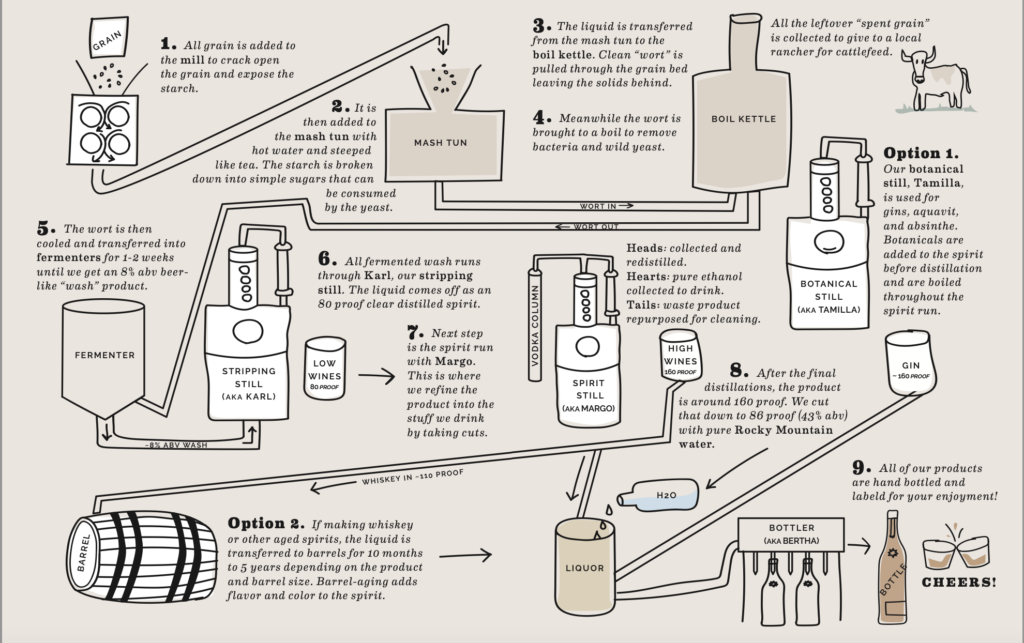In the 1700s, people went crazy for gin. No, really. The “Gin Craze” was a historical event, when suddenly common people were drinking liquor, which was previously only enjoyed by the upper classes. Daniel Defoe, a British author at the time, commented that “the Distillers have found out a way to hit the palate of the Poor.” British paupers made gin in bathtubs and sinks. Wheelbarrows clattered across the cobblestones of British cities, herbaceous liquor sloshing in rusted metal. Dutch leader William of Orange’s soldiers got drunk on it. Middlesex magistrates called it “the principal cause of all the vice & debauchery committed among the inferior sort of people.” Many died. But the cat was out of the bag, so to speak: aqua vitae, liquor infused with herbs, could be made by anyone.
All About Gin
Gin, more so than perhaps any other spirit, is emblematic of class history and how those in the direst of situations will seek relief from suffering. Had internet memes existed at the time, drinking gin would have been a great answer to the meme “What’s classy if you’re rich, but trashy if you’re poor?” To be clear, the British poor did drink, but they drank beer more often than liquor. In some cities, beer was safer than drinking water because the brewing process killed off germs.
In other parts of the world, liquor like vodka was enjoyed by everyone. But in Britain, the wealthy drank wine and brandy and the poor drank beer, until gin came around. However, people of all stripes have gone on to enjoy versatile gin as one of the most versatile cocktail mixers. We’ve set out to break down the basics of gin and why it’s remained so beloved over the years.
What is Gin?
In the broadest possible definition, it’s a neutral spirit infused with botanicals. What separates it from other herbal liqueurs like amaro is that the dominant botanical is juniper. “Some people say it tastes like pine, or like ‘Christmas,’” Vance Henderson, a brand ambassador from Hendrick’s Gin told TABLE. Henderson noted that people often love it or hate it. “Gin’s nucleus is the juniper,” he said. Its origins come from genever, a Dutch spirit from the 11th century still made today in the Netherlands.
Like vodka, gin gets its qualities from the container the distillers use and how many distillations it goes through. Each brand and style has its own process, but a basic distillation process looks a little something like this, from York Gin:

It might look like a Rube Goldberg machine, but this is a fairly simple chemical process that distillers customize depending on how much of each botanical they want your palate to experience.
Styles
Starting from the basic juniper, there are tons of variations. London Dry is the most common, created after the Gin Craze when distillers wanted to create a more refined image for the spirt. Tanqueray and Bombay Sapphire are popular London Dry bottles. “New Western/New American” refers to gin made outside of Europe that has less of a juniper-forward flavor, sometimes bringing other botanical flavors into prominence.
Old Tom gin falls somewhere in between genever and modern London Dry gin, and is much closer to the grain-derived spirit the Brits were drinking in the 1700s. Because grain spirits became hard to come by in England, gin evolved into coming from a neutral spirit and essentially becoming flavored vodka.
If you’re really brave, Navy-Proof Gin comes in at 57% alcohol—enough for a soldier to spill it on gunpowder and light the powder. Nowadays, this overproof gin is mostly used to stand up to other elements in mixed drinks.
Meet the Brands
Because it’s not as highly regulated or as specific as whiskey, there’s a lot of brand loyalty. A Tanqueray drinker probably won’t want Bombay Sapphire, and an Empress 1908 drinker probably won’t enjoy Plymouth. To show just how diverse gin can be, take a look at some of these brands and their botanicals:
- Hendrick’s, a Scottish brand which uses rose and cucumber at the end of the distillation process to give it a unique flavor. Vance Henderson described Hendricks’s strategy as “to zig when other brands zag”—they
- Bombay Sapphire, with its trademark shade of blue, is one of the most recognizable brands. It uses ten ingredients: almond, lemon peel, liquorice, lemon peel, juniper berries, orris root, angelica, coriander, cassia, cubeb, and grains of paradise.
- Plymouth, made in Plymouth, England, has an earthier flavor than London dry. It’s both the name of a brand and its own style.
- Silent Pool, made with a whopping 24 botanicals that create a bergamot and citrus aroma and a fresh flavor.
- Los Poblanos, an independently owned brand in New Mexico specializes in a lavender-based spirit. It has royal Velvet, Provence, Munstead and Buena Vista lavender combined alongside additional botanicals including hollyhock, orange, rose and lemongrass.
- Empress 1908 has a number of bottles available, but one of their most prevalent is Indigo that contains eight signature botanicals, including the butterfly pea blossom that gives it its vibrant colors.
Why Drink Gin?
While most other clear spirits you can mix with just about any other spirit, gin is more complex and stands on its own. Its aromatics are comparable to wine’s in complexity. Sometimes just smelling it is enough, before it even hits your tongue. Gin’s connection to history is part of its appeal—it can make you feel sophisticated and Victorian, part of a larger story and something bigger than yourself.
For more, check out the rest of our liquor education series:
- Get to Know Japanese Whisky
- Vodka Isn’t Just for Shots and Soda
- The Best Bottles of Tequila Blanco
- The Digestivo Digest
- Vermouth is the Apéritif You Need Right Now
Wondering what to cook to go with your drink? Try our food education series:
- Everything You Ever Wanted to Know About Olive Oil
- Knowing Spices Can Completely Change Your Kitchen Game
- How to Use Salt Correctly in Cooking
For some gin cocktails, try:
- Gin Fizz with Rizz
- Orange Soda Gin Spritz
- Gin and Jam
- Gin and Lime Juice
- Gin and Tonic with Gin Mare
- Three Guineas Dry Gin Cocktail
Story by Emma Riva
Photo courtesy of Hendrick’s Gin
Subscribe to TABLE Magazine’s print edition
